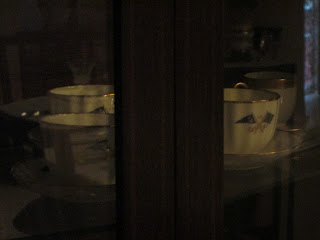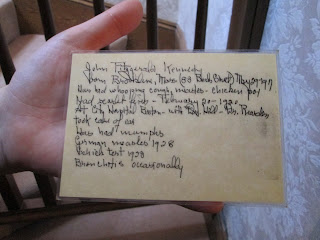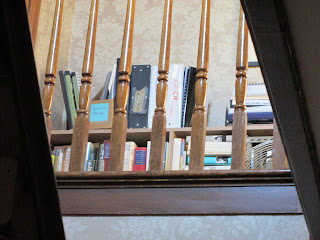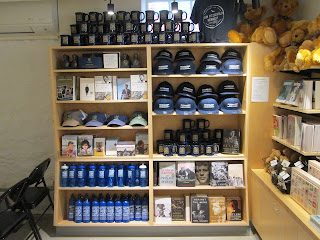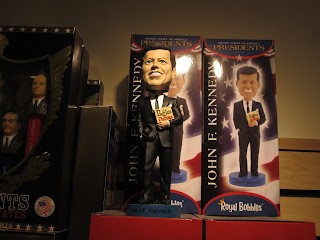Today is the sixtieth anniversary of when President John F. Kennedy, only three weeks and six days before his death, visited and delivered an address on the campus of Amherst College in Massachusetts in October. 26, 1963. In his discourse, he praised the positive impact that the arts had on our country, declaring that “if art is to nourish the roots of our culture, society must set the artist free to follow his vision wherever it takes him. We must never forget that art is not a form of propaganda; it is a form of truth.”
Now sixty years later, I would undergo another pilgrimage eighty-six miles east from the college campus where President Kennedy spoke of the impact that art has had upon on our world. I would go to very to the very place where forty-six years from 1963, in which he entered into the world. The place of which I speak of is now currently located at 83 Beals Street, also known as the John Fitzgerald Kennedy National Historic Site.
I chose to go to this site in this day for three reasons.
First, I woke up exceedingly early, much more so than I had planned and since I
did not have to work until 4:00 in the afternoon, I thought now would be the
time to visit while I have the energy. Secondly, tours of the inside of the house
would be available until November 18 of this year and so this was a limited
opportunity to visit. Otherwise, I would have to wait until next year. Third, it
was not only part because of today being the sixtieth anniversary of when President
Kennedy spoke at Amherst College, this is also sixtieth anniversary of his
final year in office for three weeks from now, we will soon commemorate the day
in which he was taken from us by an assassin’s bullet. For these reasons, I
chose to go pay my respects today to the slain president by remembering that he had once
lived.
Since I woke very early, I had a very large breakfast. I also printed out bus schedules so I could go to and from the site with expediency. I also got dressed casually and left the house at 7:40 in the morning to catch the bus, which was to arrive fifteen minutes later. It was cloudy with the temperature at 59 degrees.
I followed the same route as I had on August 12. My first bus arrived five minutes after it was scheduled, although I blame this on the morning traffic and not on the driver. Though I was anxious to arrive, I spent my time reading a copy of "JFK: Coming of Age in the American Century, (1917–1956)" by Fredrik Logevall. I read about Kennedy's time as a student at Harvard University near where the bus was heading to.
As it was on August 12, my first bus took me to Harvard Station, where I walked over to next stop at the corner of Elliot and Bennett Street. I made it to the stop just in time and with eight minutes to spare, waited for the number 66 bus to arrive.
I felt it was fitting that I was facing the school of government named after an icon whose birthplace I would soon visit.
When the second bus arrived, I got onboard. As it drove in its proper direction, I noted the students going to their morning classes. I envied them and wished that I was far younger, much more intelligent, and with a future I could look forward to.
I also noted the some of the sites I had visited before in relation to John F. Kennedy as I was heading toward the place was born. There was a bus stop simply called "J.F.K. Street."
Then there was John F. Kennedy Memorial Park, which was dedicated on the late president's seventieth birthday.
There was Harvard Stadium, where John F. Kennedy played on the university's football team for a short time.
While I was on the bus, I became concerned because I did not recall the route it had taken the last time on August 12. However, as the bus drove up Harvard Street, I was relieved because I was finally able to recall the route. After thirteen minutes, I had to get off at the corner of Harvard Street and Shailer Street, across the street from Devotion School (Ruffin Ridley School), where "from kindergarten through third grade, John F. Kennedy attended his local public school..."
Before I knew it, I arrived at the John Fitzgerald Kennedy National Historic Site.
I was also greeted by a sign on the sidewalk indicating that house would be open for tours.
Upon reading that it would soon be opened for tours, I immediately walked toward the back of the house.
I walked down the stairs and was greeted by an intern who was about to open the visitor's center, which is where the gift shop is located.
The intern politely gave me the option to either watch the orientation video first or to go on the 9:30 tour. After some hesitation and indecisiveness on my part, I chose to go on the 9:30 tour. The intern suggested that I go to the front door where a park ranger would be there to conduct the tour. I thanked her, went outside to the front of the house, walked up the steps decorated with Halloween pumpkins, and met the park ranger on the front porch.
The park ranger's name was Gabby and as expected, she did an excellent job on the tour. Before we entered the house, she showed me a large photo of a portrait of John F. Kennedy.
She then asked me, "what do you know about John F. Kennedy?" I instantly wanted to impress her, but I did not want to overwhelm her or come across as pedantic. I had to humble myself and create a good first impression. I answered that I knew that he was born on May 29, 1917, that he was the 35th president of the United States, and a few facts I knew about him.
As she was explaining the history of the Kennedy Family and of the house, an orange cat climbed up the steps to greet us. His name was Kringle who lived in the neighborhood and frequently visits the site. I petted him as he rubbed his head against my leg, and he went back down the steps onto the front lawn. It was such a joy to see him, and it brought a smile to our faces.
Gabby then proceeded to continue tell me the history of
the house. She showed me a large photo of a very young John F. Kennedy holding
hands with his older brother Joseph P. Kennedy, Jr. in front of the in
front of 83 Beals Street (which was the last house on the block at that time),
all dressed up for Easter Sunday at the approximate area where they stood
for the photograph.
Gabby then asked me why I thought Jack reacted the way he did in the photo and why he might be pointing at Joe Jr. When I said that I didn't know, she answered that it was because Joe Jr. was squeezing Jack’s hand, and Jack might be trying to get the attention of the person behind the camera. It indicated that even though the brothers loved each other and would form a stronger bond as they matured, they had an adversarial relationship and always were competing against each other, especially as children.
Gabby pointed out that the tea set on display in the glass cabinet in was given to the Kennedys by Sir Thomas Johnstone Lipton, a British merchant who founded the company known as Lipton Tea and was also a friend of the family.
She also pointed out that plates on the tables were all
hand painted by Margaret Louise Kennedy Burke (1898-1974), Joe Sr.’s
youngest sister when she was a student at Notre Dame Convent. I was immediately reminded that I had visited her final
resting place two months and seventeen days before at Holy Cross Cemetery
in Malden, Massachusetts, alongside her parents.
It was here in this room, on the second bed closest to
the window where John Fitzgerald Kennedy was brought into the world.
In a previous blog entry, I was initially incorrect in thinking that he was born in the upstairs room in the left side of the house. Now I was made aware that it was indeed the right side after all.
From the bedroom where Jack was born, we went to the nursery, where Jack spent a lot of time as a sickly child.
I saw that there were two books on the chair in front of the chair. One was a book called "King Arthur and his Knights" and the other was called "Billy Whiskers and His Kids."
According to Fredrik Logevall;s biography on page 49, Jack "loved adventure stories of all kinds - Sinbad the Sailor, Black Beauty, Peter Pan - and was especially fond of Billy Whiskers, a picture book series about a mischievous goat that marries and has two "kids." Rose found the illustrations crude and harsh, but Jack adored the tales."
Gabby noted that the bassinet, which was also in the room,
had been occupied by all the Kennedy children. She also mentioned that it was
also used by Caroline, Jack’s daughter and currently the United States Ambassador
to Australia. It made me think of a photo of then Senator John F. Kennedy playing peek-a-boo
with his infant daughter in her crib.
Gabby also noted the christening gown that the Kennedy children wore for their baptisms as infants. Rose Kennedy recalled that “the christening dress in the corner was given to me by my mother-in-law who had it made by the Franciscan nuns in East Boston where the family lived. All the children and John Jr., the president’s son, have worn this little dress. The little Irish bonnet, a gift, is profusely covered with shamrocks.”
From the nursery, we went to smaller room which looked something like a small office space. I initially thought it was Joe Sr.'s private space for himself to get extra paperwork done, until I was told that it was small study mostly occupied by Rose.
Rose mentioned that she “used this smaller room as a study. On the desk is one of my wedding invitations and some early photographs of my family. Here I did my correspondence and kept a card file on the children’s health. That was a most helpful system. I purchased a card file from the stationers near here and recorded all the important information about each of the children. It helped so much to be able to check back on the symptoms of illness, weight, diet and all the important information, such as vaccinations, Schick tests, confirmation dates, et cetera. I would recommend this idea to any mother.”
As for the study itself, it was a place where Rose oversaw every aspect over the management of her home and of the raising of her children with the help of domestic servants. She viewed this as a full-time job as important as any other working occupation.
Gabby then showed me what I what believe to be a laminated facsimile of an index card featuring John F. Kennedy's health information recorded by his mother.
Apparently, Rose listed that her second son had whooping cough, measles, chickenpox, scarlet fever, mumps, German measles, and bronchitis. According to Fredrik Logevall's biography on page 44, "in February 1920, at two years, nine months, he contracted scarlet fever, mere days after Kathleen's birth.... [Joe Kennedy Sr] enlisted his father's and father in law's help to get little Jack admitted to Boston City Hospital, even though he was not a Boston resident."
Along the walls, I saw some photographs along the walls that were relevant to Rose Kennedy in the early days of her life as daughter to the Mayor of Boston, John F. Fitzgerald.
I was then led to the guest bedroom, which was converted to a girl's bedroom as soon as Rosemary (September 13, 1918 – January 7, 2005) and Kathleen, nicked "Kick" (February 20, 1920 – May 13, 1948), were born.
Rose Kennedy once said, “in a house of this size, with
the number of children we had, this room alternated between being a guestroom
and later a children's bedroom. In those days, it had a good clear view down the
street and was a very pleasant room. It is furnished very much like our own
bedroom with the Irish linen bedspread and the silver toilet set.”
Before descending downstairs, I saw a bookcase which had a collection of different books about the Kennedy Family. I had several copies of those very same books in own my collection.
Gabby then played a 1967 audio recording of Rose Fitzgerald Kennedy speaking of the kitchen:
“There on the stove you see the bean pot. We always ate Boston baked beans on Saturday night. Warmed over for Sunday morning breakfast they were perfectly delicious with brown bread. Everyone had their special recipe for Boston baked beans and piccalilli which was usually served with them. With all the baby bottles to be sterilized, formulas to prepare, and meals to cook, this kitchen was a very busy place. During those hectic hours I would put the baby in the stroller, take two children by the hand, and with the dog following close behind, set out for the corner grocery store. On the way back we would usually stop for a visit at Saint Aidan’s church. I wanted my children to realize that church was for every day and not just for Sunday. As you leave by the back door, imagine with me the laughter of these children as they played in the warm spring sun or built snowmen in the winter. I would look out of the window occasionally to see that all went well. I hope that you have enjoyed your visit to our home. We were very happy here and although we did not know about the days ahead, we were enthusiastic and optimistic about the future.”
Before descending into the gift shop, I then thanked Gabby for the wonderful tour and that she delivered it so very well. I really appreciate the time she took in allowing me to take photos and telling me the story of the house and of its renowned occupants.
I should also mention that according to Fredrik Logevall's biography on page 46, "the Beals Street house they sold to Joe's loyal assistant and confident Edward "Eddie" Moore and his wife Mary..." Jack was about three and half years old when they moved. The house passed through three families. In 1966, through Rose's efforts, the Kennedy Family purchased the house from an owner named Martha Pollack. For the next three years, Rose supervised the restoration of the house almost entirely based on her recollections of what it might have been like when her son Jack was born in 1917 and made audio recordings of her memories of each room in the house.
When the restoration was completed, she gifted the house to the National Park Service on May 29, 1969, which would have been her second son’s fifty-second birthday. There is a photo of Rose symbolically handing over the deed of the house to the public on that day.
I then went downstairs to the visitor's center where I
viewed a twelve-minute film, "The Shaping of a President, The First Home
of John F. Kennedy," which was made in 2017, one hundred years after
President Kennedy's birth. The film showcases the historical significance of
the site and provided an understanding of the influences that shaped and
informed Jack on his journey to the presidency.
There was a moment in the short film, when highlighting the accomplishments of President Kennedy's siblings, an image of President Barack Obama awarding Ambassador Jean Kennedy Smith the Presidential Medal of Freedom in the East Room in the White House on February 15, 2011, appeared on the screen.
I was instantly and delightedly reminded of the time I met Ambassador Smith at the John F. Kennedy Presidential Library and Museum on the night of January 24, 2017. Meeting her was the foundation of why I made the pilgrimage to the birthplace of her big brother.
I then saw another image of her with four of her siblings: Patricia, Bobby, Eunice, and Jack.
The film concluded by telling the story of when in the days after President Kennedy was assassinated in November of 1963, thousands of people gathered at 83 Beals Street in Brookline, to pay their respects, join in prayer, and reflect on someone they felt deeply connected to. The newspapers described this as "final tribute to its most eminent son."
The film briefly mentioned that Rose Kennedy established the house as a gift to the American people as she said, "So that future generations will be able to visit it and see how people lived in 1917 and thus get a better appreciation of the history of this wonderful country."
The film then closed with brief sentences from two of President Kennedy's speeches as it showcased images of the young world leader ready to take up the challenge. The first sentence came from his address before the Irish Parliament on June 28, 1963: "The problems of the world cannot possibly be solved by skeptics or cynics whose horizons are limited by the obvious realities. We need men who can dream of things that never were and ask, "why not?".
The second quotation came from his remarks recorded for the opening of a USIA transmitter at Greenville, North Carolina on February 8, 1963: "A man may die, nations may rise and fall, but an idea lives on."
The final image shown was a photo of Senator John F. Kennedy greeting a roadside crowd during a campaign trip in Indiana on October 5, 1960. Then it faded to black.
After seeing the short film, I then took photos of the merchandise on display in the gift shop. All of which I desire to have and as gifts I wish to give to friends with likeminded interests.
There were three hardcover books I desire to have in my Kennedy Book Collection.
They were “Incomparable Grace: JFK in the Presidency” by Mark K. Updegrove
“The Kennedy Withdrawal: Camelot and the American
Commitment to Vietnam” by Marc J.
Selverstone
And "Against the Wind: Edward Kennedy and the Rise of Conservatism, 1976-2009" by Neal Gabler.
I already have his first volume "Catching the Wind: Edward Kennedy and the Liberal Hour, 1932-1975", which I bought in February of 2021. I wanted to add it and put it next to my copy of Mr. Gabler’s previous volume to have a sense of completion to that set.
Overall, I spent one hour at the John Fitzgerald Kennedy National Historic Site, with a tour lasting only thirty minutes. I am glad that I came and that I visited on this day. To conclude this blog entry, I want to share an excerpt from the speech that President Kennedy gave on campus of Amherst College sixty years ago today. An excerpt was also highlighted in the video I viewed at the at visitor's center at his birthplace so I thought it would be fitting to share his words here to serve as a conclusion.
He said, "I look forward to a great future for America, a future in which our country will match its military strength with our moral restraint, its wealth with our wisdom, its power with our purpose. I look forward to an America which will not be afraid of grace and beauty, which will protect the beauty of our natural environment, which will preserve the great old American houses and squares and parks of our national past, and which will build handsome and balanced cities for our future.
I look forward to an America which will reward
achievement in the arts as we reward achievement in business or statecraft. I
look forward to an America which will steadily raise the standards of artistic
accomplishment, and which will steadily enlarge cultural opportunities for all
of our citizens. And I look forward to an America which commands respect
throughout the world not only for its strength but for its civilization as
well. And I look forward to a world which will be safe not only for democracy and
diversity but also for personal distinction."
.jpg)































